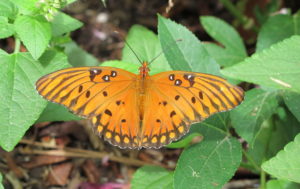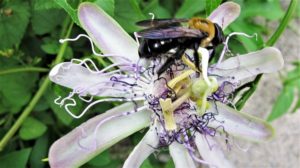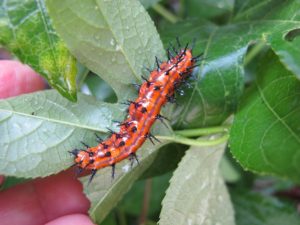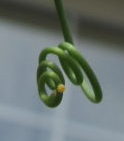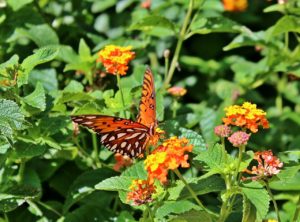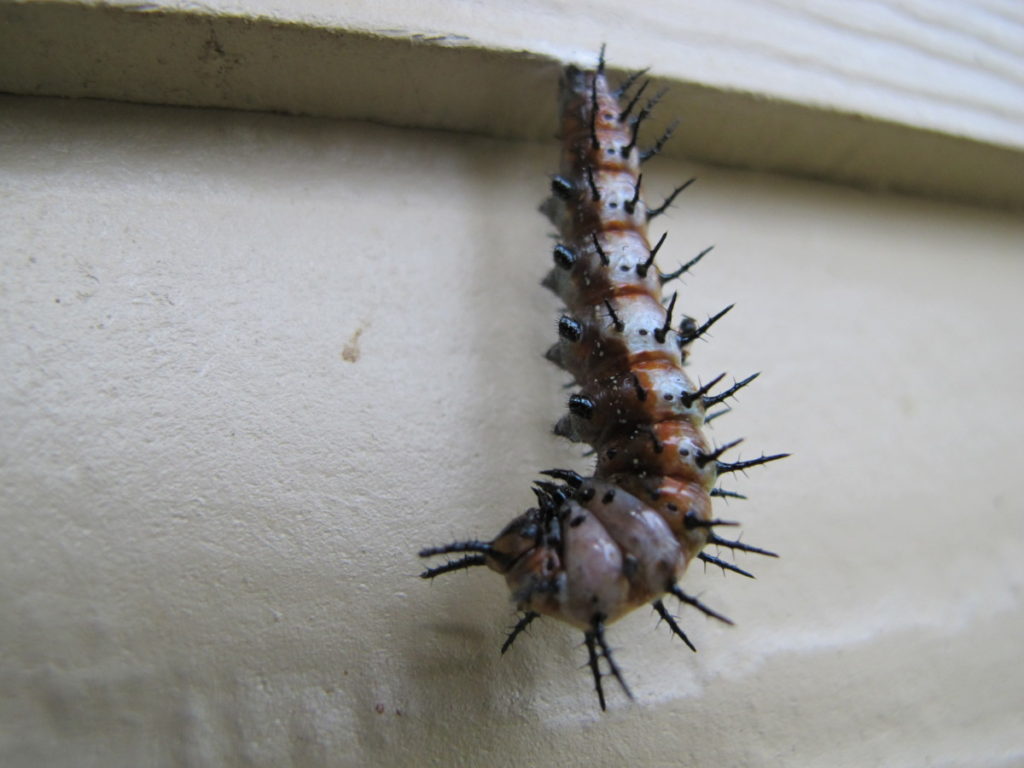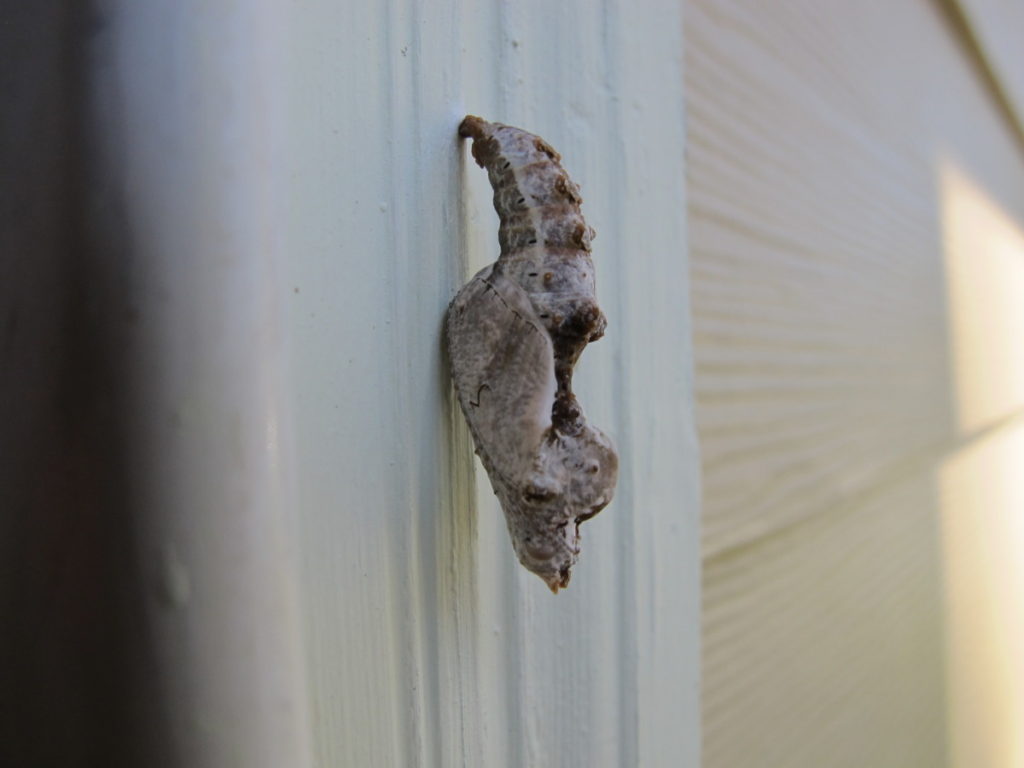The Gulf Fritillary Butterfly
At the Hendersonville Garden Jubilee in May, I bought a small Passiflora vine as a gesture of support for Bee City USA. One third of the food we eat and 80% to 90% of all flowering plants rely on pollinators to set fruit and, therefore, to reproduce. Bees are efficient pollinators, but other insects and animals, including butterflies, beetles, moths, bats, and hummingbirds, also provide this service. This article concentrates on attracting the gulf fritillary butterfly to your garden.
Passiflora incarnata
Planting the passionflower vine had to be delayed until late summer, after the siding replacement had been completed. And then the plant took off!
Passionflower vine (Passiflora incarnata), also called maypop, is the primary food source for larvae of the beautiful gulf fritillary butterfly. This herbaceous perennial is native to the southeastern quadrant of the U.S., in USDA zones 5 to 9. A substantial vine, growing to 20′ in length, it blooms from late spring to late summer. Its pale purple 3″ flowers yield kiwi-size yellow-orange fruits from which you can make jams and jellies, although I haven’t tried it.
Other species of Passiflora can host larval fritillary populations, but some are toxic and will kill the caterpillars. So, choose carefully! Usually, the female senses chemicals with her antennae and determines suitability of a particular plant for oviposition (depositing the eggs).
Passionflower vines also host the variegated fritillary, the Mexican fritillary, the Julia butterfly, and the zebra longwing. I was hopeful but not overly optimistic that the caterpillars would show up this late in the season. But I have since learned that caterpillar activity of the gulf fritillary ordinarily takes place in late summer.
If You Plant It, They Will Come
It wasn’t long before the vine had wrapped its tendrils around the coleus and the Salvia coccinea planted only 2′ away.
I saw the bright orange butterflies a few times this summer, flying around the gardens. But now they visited the vine almost every day to lay eggs, and then the nearby hanging basket of flowers to sip nectar. Adults feed only on nectar, including flowers of lantana, zinnia, Buddleia (butterfly bush), salvia, and Liatris.
Soon, holes appeared in the leaves…already?…and then bigger holes. Success! Long gone are the days when I would have implemented measures to “remedy” this behavior.
Close inspection revealed several orange caterpillars with purplish stripes and black bristly projections. Then more appeared, wave after wave, as the older ones matured and crawled away to pupate. I would not have thought that a plant this small could sustain more than 40 caterpillars over a few short months. But it did, although some chrysalises have succumbed to a fungal disease. Recently I noticed more small caterpillars, even though we’ve already had a light frost.
Thank goodness, I thought, because this garden isn’t large enough for this vigorous vine. These caterpillars and their voracious appetites will help keep this young plant in bounds. The plan is to dig it up and to transplant it to a bigger garden, when I move. I’ll remove all that I see, or they will take over the neighbors’ gardens as well.
Life Cycle of the Gulf Fritillary Butterfly
Gulf fritillaries (Agraulis vanillae) are commonly found in open sunny habitat, grasslands, woodlands, fields, and in gardens. These subtropical butterflies range from Texas to Florida and migrate north from Missouri to Delaware. This butterfly is also found in Central America and in Hawaii.
The gulf fritillary and the zebra butterflies belong to a group called the longwings (Heliconiinae). Larvae of both species feed on passionflower vines. Although the gulf fritillary resembles other fritillaries, it is, in fact one of the longwings. Other fritillary larvae (meadow and great spangled) feed on wild violets.
Predators avoid longwing butterflies due to several odorous chemicals produced in abdominal glands. Passionflowers contain poisons (alkaloids, cyanogenic glycosides), which are picked up by the caterpillars. These chemicals make them distasteful to birds and other animals, but less so in the gulf fritillary.
After mating and consuming protein-rich pollen for several days, the female butterflies lay eggs on passionflower vines. This caterpillar prefers mature foliage, if it is plentiful, leaving other butterfly caterpillars to feed on the young leaves at the tips. I’ve read conflicting information, which states their preference for the young growth tips of the vines. There, the plant doesn’t produce nectaries on its foliage, which attract ants that defend the plant from butterflies and larvae.
Adults measure about 2 1/2″ to 3 1/2″ wide, with females being larger and a bit darker than the males. Females also have more pronounced markings, and both have white spots on the undersides of their wings.
Eggs and Larvae
Eggs are yellow when first laid. They hatch in 3 to 8 days, depending on temperature.
The caterpillar molts 4 or 5 times over the next 11 to 20 days, and then crawls to a suitable point of attachment for its chrysalis. For 5 to 12 days, according to the websites I read, the caterpillar pupates. But the chrysalis by the front door (below, right) has been hanging around for at least 2 weeks. It is alive; it reacts when I nudge it. A small sign just under the doorbell, where the pupa resides, requests “Please Do Not Disturb.”
- Typical J-shaped caterpillar about to form chrysalis.
- Fully formed chrysalis.
The small chrysalis, at only 1 1/8″ in length, could easily be mistaken for leafy debris. But hanging on the door trim or on the shutters, it becomes conspicuous. In fact, the first chrysalis I saw, also on the door trim, had been partially eaten, probably by a resident lizard. Although I’m tempted to move them to the shrubs to “save” them, it’s better to let nature decide. If this were a rare species, I might think differently. (***Update***: Well, someone dined on this chrysalis, too! 11/2019.)
Adults typically live for a few to several weeks in warm weather, and longer in cooler temperatures. This butterfly prefers warmer regions, and dies when it gets close to 20°F. The gulf fritillary butterfly can produce several generations per year in warm winter zones.
Typical Butterfly Life Cycle
The typical life cycle of a butterfly:
- starts as an egg,
- which hatches into a caterpillar (the larval stage),
- which pupates in the chrysalis (the pupal stage), undergoing metamorphosis,
- and then emerges as the adult butterfly.
The gulf fritillary overwinters in cooler zones as adults. Do them a big favor and build a brush pile where they can find shelter in cold and inclement weather. Simply stack piles of twigs, branches, straw, and weeds, and let fallen leaves blow in. Birds, insects, and other creatures will appreciate this kind gesture. And you’ll get some compost out of it.
I give the results of this small experiment Four Stars, an A+. As I mentioned earlier, I was pleasantly surprised by how readily the butterflies found the passionflower vine, and by the number of caterpillars feeding from it. If you’ve been considering what to plant to attract pollinators or pretty butterflies, you won’t go wrong with this one. Just give it some space!
